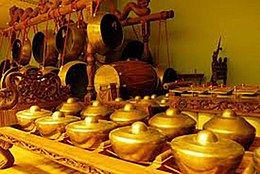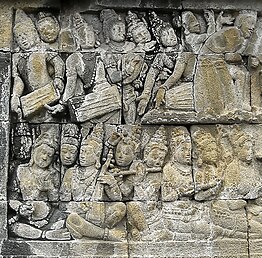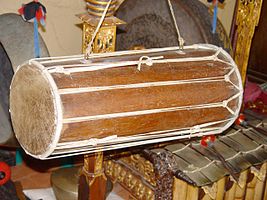Kendang
 | |
| Inventor(s) | Javanese, Sundanese, Balinese |
|---|---|
| Developed | Indonesia[1][2] |
| Gamelan | |
|---|---|
 Gamelan musical instrument | |
| Country | Indonesia |
| Domains | Traditional craftsmanship, oral traditions and expressions, performing arts, knowledge and practices concerning nature and the universe, social practices, rituals and festive events |
| Reference | 01607 |
| Region | Asia and the Pacific |
| Inscription history | |
| Inscription | 2021 (16th session) |
| List | Representative List |
 Gamelan variations consist of: Javanese gamelan (gamelan jawa) of Central Java and Special Region of Yogyakarta, Balinese gamelan (gamelan bali) of Bali, Sundanese gamelan (gamelan sunda) of West Java, Madurese gamelan (gamelan madura), Malay gamelan (gamelan melayu), Banyuwangian Gamelan (gamelan banyuwangi) of East Java, Palembangese gamelan (gamelan palembang) of Palembang, Gendang beleq of West Nusa Tenggara, Banjarese gamelan (gamelan banjar) of South Kalimantan, Gamelan peking of Lampung, and Talempong of West Sumatra. Gamelan instruments: slab-type (wilahan) instruments (saron/sarun/pemade, demung/sarun ganal, Gendèr/kiliningan, slenthem/selentem/jegogan, peking/sarun paking/kantilan, kecrek/keprak), gong-type (pencon) instruments (gong, kempul, kenong, bonang, trompong, kethuk, talempong, kempyang), String instruments (siter, celempung, kecapi, rebab), Bamboo instrument (suling), Drums instruments (kendhang, Bedug, ketipung, gendang beleq), Wooden instrument (gambang) Idiophone instrument (kemanak) | |

Kendang or Gendang is a two-headed drum. It is used by people from the Indonesian Archipelago. Kendang is one of the first instruments used in the Gamelan ensembles of Javanese, Sundanese, and Balinese, the Kendang ensemble as well as various Kulintang ensembles in Indonesia. It is made in many ways by different ethnic groups.
Accompaniments[change | change source]
Sundanese[change | change source]
In Sundanese Gamelan, a minimum set consists of three drums.[3]
- Kendang Indung (large drum)
- Kendang Kulanter, two (small drum). Kendang Kulanter is divided into two, namely the Katipung and the Kutiplak.
Many types of Sundanese Kendang are distinguished according to their function in accompaniment :
- Kendang Kiliningan
- Kendang Jaipongan
- Kendang Ketuk Tilu
- Kendang Keurseus
- Kendang Penca
- Kendang Bajidor
- Kendang Sisingaan and others.
Each type of drums in Sundanese music has a difference in size, pattern, variety, and motif.
Javanese[change | change source]
In Gamelan Surakarta, four sizes of kendhang are used:[4]
- Kendhang ageng, kendhang gede (krama/ngoko, similar to gong ageng), or kendhang gendhing is the largest kendang, which usually has the deepest tone. It is played by itself in the kendhang satunggal (lit. "single drum") style, which is used for the most solemn or majestic pieces or parts of pieces. It is played with the kendhang ketipung for kendhang kalih (lit. "double drum") style, which is used in faster tempos and less solemn pieces.
- Kendhang wayang is also medium-sized, and was traditionally used to accompany wayang performances, although now other drums can be used as well.
- Kendhang batangan or kendhang ciblon[5] is a medium-sized drum, used for the most complex or lively rhythms. It is typically used for livelier sections within a piece. The word ciblon derives from a Javanese type of water-play, where people smack the water with different hand shapes to give different sounds and complex rhythms. The technique of this kendang, which is said to imitate the water-play,[6] is more difficult to learn than the other kendang styles.
- Kendhang ketipung is the smallest kendang, used with the kendang ageng in kendhang kalih (double drum) style.
Balinese[change | change source]
In Balinese Gamelan, there are two kendang:[7]
- Kendang wadon, the "female" and lowest pitched.
- Kendang lanang, the "male" and highest pitched.
Makassarese[change | change source]
Ganrang (Makassarese kendangs) can be divided to three types:[8]
- Ganrang Mangkasarak is the largest drums as a result it is also called Ganrang Lompo (largest drum in Makassarese language).These drums are usually used in important sacred ceremonies such as blessing for sultanate's heirlooms.
- Ganrang Pakarena are usually smaller with diameters measuring in 30–40 cm, which are usually used for Pakarena dance, which used 2-4 drums with differing beats and symbolizes the men's strength and vitality.
- Ganrang Pamancak are usually the smallest with diameters measuring in 20–25 cm, and used as martial arts accompaniments.
Buginese[change | change source]
Among the Bugis Gendrang there are two types of playing techniques based on the position of the gendrang. if the gendrang is placed on the player's lap it is called mappalece gendrang. If the players are standing with the gendrangs tied with a shoulder strap it is called maggendrang tettong, this position are usually used for sacred ceremony, or for entertainment like beating of rice mortars or mappadendang. There are generally three types of beats pattern in gendrang playing:[9]
- Pammulang patterns are usually the beginning as intro
- Bali Sumange are played afterwards which are usually more energetic
- Kanjara patterns are used afterward, as finale.
Gallery[change | change source]
-
Kendang of Java, one side is bigger than other.
Related pages[change | change source]
Sources[change | change source]
- ↑ "Kendang".
- ↑ Kartomi, Margaret J.; Heins, Ernst; Ornstein, Ruby (2001). "Kendang". Kendang. Grove Music Online. doi:10.1093/gmo/9781561592630.article.14877.
- ↑ Sunarto (2015). Kendang Sunda (in Indonesian). Penerbit Sunan Ambu Press, STSI Bandung. ISBN 978-979-8967-50-4.
- ↑ "Kendang". Archived from the original on 2021-12-19. Retrieved 2021-12-19.
- ↑ https://omeka1.grinnell.edu/MusicalInstruments/exhibits/show/ens/item/82[permanent dead link]
- ↑ Lindsay, Jennifer (1992). Javanese Gamelan, p.22. ISBN 0-19-588582-1. "The technique of kendang ciblon is very difficult to acquire.Ciblon is the Javanese name for a type of water-play, popular in villages, where a group of people, through smacking the water with different hand-shapes, produce complex sounds and rhythmic patterns. These sounds are imitated on the dance drum."
- ↑ "The Instruments for Gamelan Bali". Archived from the original on 2012-11-03. Retrieved 2019-10-20.
- ↑ "Gandrang, Alat Musik Tradisional Makassar – Balai Pelestarian Nilai Budaya Sulawesi Selatan". Archived from the original on 2021-12-19. Retrieved 2021-12-19.
- ↑ Rachmat, Rachmat; Sumaryanto, Totok; Sunarto, Sunarto (2020). "Klasifikasi Instrumen Gendang Bugis (Gendrang) Dalam Konteks Masyarakat Kabupaten Soppeng Sulawesi Selatan". Jurnal Pakarena. 3 (2): 40. doi:10.26858/p.v3i2.13064. S2CID 226030960.
Further reading[change | change source]
- Sumarsam. Javanese Gamelan Instruments and Vocalists. 1978-1979.
Other websites[change | change source]
- Kendang information, with audio Archived 2021-12-19 at the Wayback Machine
- Rampak Kendang in Google.





